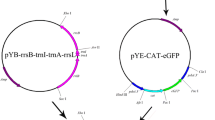Abstract
A genetic transformation model for the seaweedLaminaria japonica mainly includes the following aspects:
-
1.
The method to introduce foreign genes into the kelp,L. japonica
Biolistic bombardment has been proved to be an effective method to bombard foreign DNA through cell walls into intact cells of both sporophytes and gametophytes. The expression ofcat andlacZ was detected in regenerated sporophytes, which suggests that this method could induce random integration of foreign genes.
Promoters to drive gene expression
-
2.
The CaMV35S promoter was first used by us to induce the expression of GUS gene in brown algae. But results of further studies suggested that CaMV35S could be a tissue-specific promoter. Our use of SV40 promoter resulted in both transient and stable expression oflacZ andcat in sporophytes or gametophytes. No GUS or LacZ background was found in either sporophytes or gametophytes.The regeneration route of transgenic kelp
The regeneration efficiency of explants is still very low. By using female gametophytes as gene hosts and parthenogenesis as regeneration route, CAT activity and LacZ activity were detected in regenerated sporophytes of parthenogenetic kelp. li]4.|The way to select transgenic kelp
-
1.
Results of sensitivity tests showed that kelp was only sensitive to chloramphenicol and hygromycin among many antibiotics. The regenerated sporophytes by parthenogenesis were more sensitive to hygromycin than to chloramphenicol. Resistant kelp was created by transforming female gametophytes with pSV40-CAT and stimulating parthenogenesis followed by selection in medium with lethal concentration of chloramphenicol.
Safety consideration of transgenic kelp
L. japonica was originally introduced from Japan. In China it is a cultured population. The possibility of its negative impact on natural populations is very low. 2) The vectors and target genes used for transformation should be restricted in order to avoid any negative impacts on human health and environment. 3) Specially devised containers (3.6 L, made of 200 μm membrane) were used to ensure that the kelp cannot escape or be eaten by marine animals. 4) To avoid the release of spores, it is very necessary to harvest the kelp at suitable age before the sporangium forms.
Similar content being viewed by others
References
Fang, Z., Dai, J., Cui J. et al., 1978. The first record of female sporophytes ofLaminaria japonica.Chin. Sci. Bull. 23:43–44.
Henry, E. C., Meints, R. H., 1994. Recombinant viruses as transformation vectors of marine macroalgae.J. Appl. Phycol. 6:247–253.
Lewis, R. J., Jiang, B. Y., Neushul M. et al., 1993. Haploid parthenogenetic sporophytes ofLaminaria japonica (Phaeophyceae).J. Phycol. 29:363–369.
Li, X., Qin, S., Peng, J. et al., 1998. Sensitivity of sporophytes of parthenogeneticLaminaria japonica to chloramphenicol and hygromycin.Oceanol. Limnol. Sin. (in Press) (in Chinese with English abstract)
Notoya, M., Nagashima, M., Aruga, Y., 1992. Influence of light intensity and temperature on callus development in young sporophytes of four species of Laminariales (Phaeophyta).Kor. J. Phycol. 7(1):101–107.
Notoya, M., Nagashima, M., Aruga, Y., 1994. Influence of light intensity and temperature on callus development in young sporophytes of three species of Laminariales (Phaeophyta).J. Mar. Biotech. 2:15–18.
Qin S., Zhang, J., Li, W. et al., 1994. Transient expression of GUS gene in phaeophytes using Biolistic particle delivery system.Oceanol. Limnol. Sin. 25(4):353–356. (in Chinese with English abstract)
Qin, S., Wu, J., Wang, X. et al., 1997. The expression of foreign genes inLaminaria japonica (Phaeophyta).In: The Marine Biology of South China Sea. (ed. B. Morton) Hong Kong University Press, Hong Kong, p. 3–11.
Qin, S., Jiang, P., Li, X. et al., 1998. The expression oflacZ in regenerated sporophytes of parthenogeneticLaminaria japonica. In: Proc. 2nd Asia-Pacific Mar. Biotech. Conf. 3rd Asia-Pacific Conf. Algal Biotech. (in Press)
Qin, S., Kojima, H., Kawata, Y. et al., 1998. Cloning and sequencing of the allophycocyanin genes fromSpirulina maxima (Cyanophyta).Chin. J. Oceanol. Limnol. 16 (suppl.):6–11.
Saga, N., Sakai, Y., 1984. Isolation of protoplasts fromLaminaria andPorphyra.Bull. Jap. Soc. Sci. Fish. 50:1085.
Tseng, C. K., Qin, S., 1991. Marine algal biotechnology in China: Present conditions and prospects,In: Proceeding of International Symposium on Biotechnology of Salt Ponds, Tianjin, p. 61–68.
Wang, X., Qin, S., Li, X. et al., 1998a. Effects of ultrasonic treatment on female gametophytes ofLaminaria japonica (Phaeophyta).Chin. J. Oceanol. Limnol. 16(suppl.):62–66.
Wang, X., Qin, S., Li, X. et al., 1998b. Highly efficient induction of callus and regeneration of sporophytes inLaminaria japonica (Phaeophyta).Chin. J. Oceanol. Limnol. 16(suppl.):67–74.
Wu, J., 1996. Study of selectable markers and expression of foreign genes inLaminaria japonica, Master Thesis, Institute of Oceanology, Chinese Academy of Sciences.
Author information
Authors and Affiliations
Additional information
Contribution No. 3354 from the Institute of Oceanology, Chinese Academy of Sciences
Rights and permissions
About this article
Cite this article
Song, Q., Peng, J., Xin-ping, L. et al. A transformation model forLaminaria Japonica (Phaeophyta, Laminariales). Chin. J. Ocean. Limnol. 16 (Suppl 1), 50–55 (1998). https://doi.org/10.1007/BF02849080
Issue Date:
DOI: https://doi.org/10.1007/BF02849080




